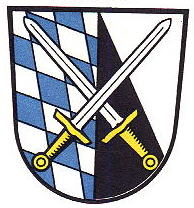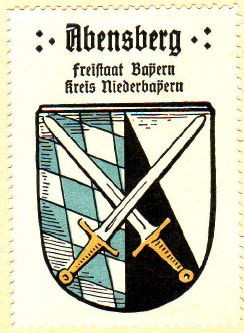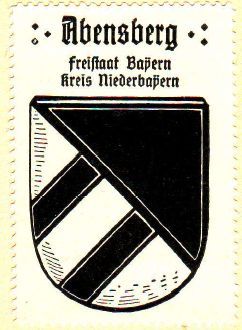Abensberg: Difference between revisions
Knorrepoes (talk | contribs) (Created page with '{|width="100%" style="color:black; background-color:#ffffcc;" |width="15%"|50 px|left |width="70%" align="center" |'''Heraldry of the World<br/>Civic heraldr…') |
Knorrepoes (talk | contribs) No edit summary |
||
| Line 9: | Line 9: | ||
State : [[Bayern]]<br/> | State : [[Bayern]]<br/> | ||
District (Kreis) : [[Kelheim (kreis)|Kelheim]] | District (Kreis) : [[Kelheim (kreis)|Kelheim]]<br> | ||
Additions : 1939 Aunkofen; 1972 Arnhofen, Holzharlanden, Pullach, Sandharlanden; 1975 Hörlbach; 1978 Offenstetten | |||
[[File:abensber.jpg|center]] | [[File:abensber.jpg|center]] | ||
Revision as of 11:47, 28 January 2011
| Heraldry of the World Civic heraldry of Germany - Deutsche Wappen (Gemeindewappen/Kreiswappen) |
ABENSBERG
State : Bayern
District (Kreis) : Kelheim
Additions : 1939 Aunkofen; 1972 Arnhofen, Holzharlanden, Pullach, Sandharlanden; 1975 Hörlbach; 1978 Offenstetten
Origin/meaning :
The arms were granted on December 31, 1809 by King Max I Joseph of Bayern.
The left half of the arms show the divided shield of the Lords of Abensberg, which lived in the city until their extinction in 1485. The oldest seals, known from the late 14th century, show the divided shield with an extra bend to distinguish the arms from those of the family.
The right half shows the blue and white diamonds of the Willelsbach family, Kings of Bayern. The two crossed swords are a symbol of the Battle of Kelheim in 1809, in which a combined French-Bavarian army defeated the Austrians.
Previously the city used the arms shown below right. These are based on the arms of the Lords of Abensberg, who ruled the town from the 10th century until 1845. The family used as arms a shield divided bep bend of silver and black. On the oldest known seal of the city, dating from 1319 there is an additional bend visible. Since 1399 the seals show two bends as in the arms below.
| The two arms in the Kaffee Hag albums +/- 1925 |
|
Literature : Stadler, 1964-1971, 8 volumes; Hupp, O: Kaffee Hag albums, 1920s



